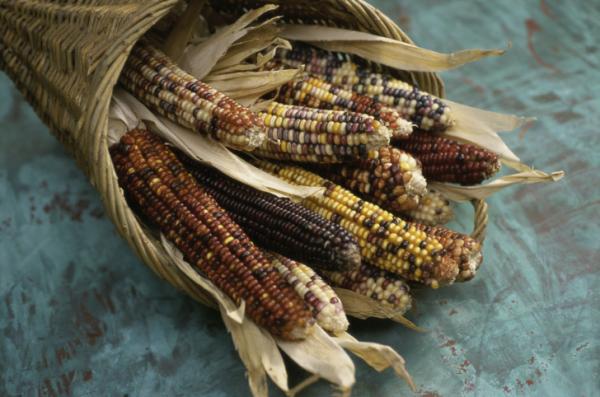Tulalip Tribes Natural Resources is hosting three workshops on rainwater management, beginning Wednesday, March 12, 2014
The Invisibles: Seattle’s Native Americans
They’re rarely seen or heard, but the statistics on the population’s health, education, and happiness speak loud and clear.
By Matt Driscoll Mar 4 2014 Seattle Weekly
Rose Gibbs is tough. Behind a youthful face and crystal-clear brown eyes resides a person hardened beyond her years. She’s been in foster care for the past five, citing her mother’s alcoholism as the reason she and six of her siblings landed there. At 15, she wears a San Francisco 49ers beanie and a look of unease when talking to a reporter. She says she “had to grow up too fast,” and it’s hard not to agree with her. Rose, who identifies as both Latina and a member of the First Nations Lyackson Tribe, is currently attending Ingraham High School in north Seattle. In the course of her life, including stints in Canada, Rose says she’s gone to “more than 10, maybe 20” schools. She thinks seven of those have been in the Seattle School District, but she’s not sure.
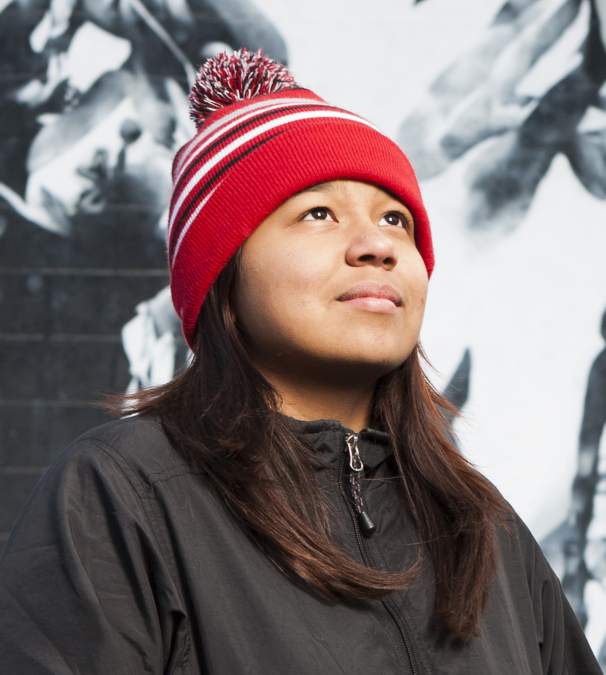 “I guess, I don’t know. I honestly forgot,” she says. “There’s a big blank, between when I was younger and now. I really don’t remember.”
“I guess, I don’t know. I honestly forgot,” she says. “There’s a big blank, between when I was younger and now. I really don’t remember.”
It’s an understated and understandable answer from a girl who seems accustomed to hiding vulnerability with aloof, indifferent distance. But it doesn’t take much to push past Rose’s hardened front.
“It happened in fourth grade,” she says of the moment alcohol and domestic violence collided, altering her life’s trajectory in an instant.
And then tears.
Rose rarely sees her mom these days, she says after a wrenching pause. Since then she’s spent time with five foster families, but hasn’t felt at home with any of them. She’s stubborn, she admits, and looks forward to her last two years “in the system.” She says she misses her siblings, and hopes one day to reunite with them.
Rose started coming to the Urban Native Education Alliance’s Clear Sky Native Youth Council, where I met her, back in April. At this point she’s what UNEA Chair Sarah Sense-Wilson describes as a “regular,” with an “indomitable spirit” —and a good example of exactly the kind of local kid the nonprofit tries to reach. Through Clear Sky, the UNEA offers tutoring, art, a sense of cultural belonging, and—perhaps most anticipated—a solid meal to urban Native American kids who need it. As it turns out, plenty in the Seattle area do.
Rose and I are seated at a round table inside the Seattle School District’s Wilson-Pacific Building. Compared to my previous visit to Clear Sky, where I’d first met Rose three weeks ago, things are considerably more comfortable. There’s heat this time. And bathrooms that work. On my first visit, the urban Native kids who come to Clear Sky gathered in a cafeteria toward the back of the soon-to-be-razed school building. The missing tiles from the ceiling and floor, and the sign on the door reading “RESTROOMS CLOSED/NO WATER” gave the gym an air of abandonment.
But tonight’s different. The meeting has been moved to a new room, and the upgrade is palpable. UNEA Co-Chair Mary Ann Peltier, who is from the Chippewa, Assiniboine and Sioux tribes, spills the details: They struck a deal with the school district, agreeing to pay $18.35 a night for the improved amenities.
A bad building wasn’t keeping Clear Sky from working its magic, however. While jackets were sometimes required, the decrepit, mural-covered cafeteria at the back of the Wilson-Pacific building was enough for Peltier and Sense-Wilson, a straight-shooting member of the Oglala Sioux tribe, to roll up their sleeves and get to work in. The UNEA’s flagship program, Cleark Sky held its first meeting in 2009, and they’ve been at it every week since.
“You donate?” Sense-Wilson drills me, nearly the moment we meet. “I’m just kidding. I know writers don’t make much money. ”
Sense-Wilson smiles as she ribs me. The room is abuzz. Subway sandwiches are on the menu, along with a class called “‘Native Journalism 21st Century.” The Clear Sky mission of promoting “cultural, traditional activities and educational achievement” is alive around us. Though the UNEA also offers a basketball program and various other special events geared toward the urban Native population, the Clear Sky Youth council is the nonprofit’s gem. Sense-Wilson says the program provides academic support for “ensuring the success of Native learners,” and boasts a 100 percent high-school graduation rate.
Outside the walls, however, things get difficult for young urban Natives like Rose, who live off the reservation, a minority among minorities in the city. According to census data, only .8 percent of Seattle identifies as an American Indian and Alaska Native alone —a mere blip in a city named after Chief Sealth which was home to Native peoples thousands of years before a white person ever set foot here. It’s a demographic that faces a daunting set of challenges.
“You can turn a corner and see someone you relate to,” Peltier tells this white reporter. “I can turn many corners, and won’t relate to anyone.”
It can be lonely, and worse. And it isn’t getting better. According to information presented in the Seattle’s Race and Social Justice Initiative three-year plan for 2012 to 2014, American Community Surveys over the last 20 years show that the poverty rate for Natives in Seattle has fluctuated, but only slightly. In 1990, 33 percent of Natives lived in poverty; in 2000, it was 29 percent; by 2009, it was back up to 30 percent. That’s higher than the poverty rate for any other ethnic group. Meanwhile, the poverty rate for white Seattleites has stayed steady at just 9 percent.
For urban Native kids, the stats can look even worse. According to the “Community Health Profile” for the Seattle Indian Health Board released in December 2011, in King County 46.6 percent of American Indian and Alaska Native children under age 6 lived below the poverty line between 2005 and 2009, compared to 13.2 percent of children in the general population.
The difficulties only continue from there, and for a population as small, diverse, and historically maligned as this one, even finding a starting point from which to dig out can seem daunting. They include the pronounced education achievement gap between Native students and whites, resulting in historically low graduation rates and high dropout rates for American Indian and Native Alaskan students; numerous health concerns, from asthma to diabetes and obesity; addiction and alcoholism; domestic violence; a disproportionate rate of homelessness; and institutional neglect. And the fact that Natives, 1.5 percent of the overall population, make up 4.4 percent of Washington’s prison population.
There’s also the simple fact that placing an umbrella ethnic classification like “Native American” over a group of city-dwelling people from hundreds of tribes and countless cultural traditions simply doesn’t accurately define it.
As a result, the population often fades into the firmament.
“Sometimes I don’t think they see us,” Rose says. It’s a common sentiment. Changing people’s fortunes—as Clear Sky aims to do—often begins with confronting this sense of aloneness, pounded into Seattle’s Natives by politics, policy, perceptions, and nearly 200 years of history.
“To not have any representation that reflects who you are, or honors your cultural, your tradition, your history, it’s really a profound psychological, oppressive place to be,” Sense-Wilson says.
Clear Sky is a bright spot. Looking around on this Tuesday night, there is hope to be had. There’s Rose and her improved grades and self-worth. There are the other 40 or so kids who have arrived, each equally important. There are Sense-Wilson, Peltier, and the other adult volunteers, filling a need for their community when no one else did. And there are smiles.
You get the feeling that if the uncertain future of Seattle’s urban Native community is to be bright, it will likely start with exactly the kind of thing happening here.
“When we do see each other, we know,” Peltier says of the Native community in Seattle and what happens at Clear Sky. “We know when we connect.”
Call it a starting point.
It’s cold outside when the January 17 gathering of the state House’s Community Development, Housing & Tribal Affairs Committee comes to order—the kind of miserable weather Olympia is known for. On the docket is a work session titled “The Urban Indian Experience.”
With only the very occasional yawn, the seven lawmakers who make up the committee have come together this Friday afternoon to learn about the plight of urban Native Americans. For the elected policy-makers, it’s a chance to learn. For those invited to teach them, it’s a chance to have a voice in the halls of power.
Ralph Forquera, a member of the Juaneño Band of California Mission Indians and the executive director of the Seattle Indian Health Board, is first up. The semicircle of seated decision-makers listens as he gets into specifics, trying his best to describe the 29 federally recognized tribes and six unrecognized ones that meld together, along with countless individual Native transplants from across the continent, to make up our state’s remarkably diverse urban Native population. (Nationally, there are 566 federally recognized tribes and hundreds of unrecognized ones.) It’s no easy task, which is part of the larger problem.
The population is mixed, with varying ties to local, national, Canadian, and Alaska Native tribes, Forquera tells them. Some, like the 4,809 Seattle residents who identified as American Indian or Alaska Native alone in 2010, show up on the census. Many more don’t, for reasons both simple and complex. Who is an American Indian these days, and who marks the box when asked? “It’s a very difficult question to answer,” Mark Trahant, a former editor of the Seattle Post-Intelligencer editorial page and current Atwood Chair of Journalism at the University of Alaska Anchorage, tells Seattle Weekly. Trahant, a member of the Shoshone-Bannock tribes and the former president of the Native American Journalists Association, has written extensively on the lack of clear data on the Native population.
Some Natives have long hesitated to identify themselves for statistical purposes, Trahant says by phone from his office in Alaska. Others have unclear or mixed ethnic identities. How much of a connection must one have to identify as Native? What’s required by the tribe? Different ones have different standards, Trahant notes. And what about the growing generations of urban Natives off the reservations? How can we accurately account for them? None of these questions have easy answers, he says.
“Census is not very sensitive to tribe, it’s more sensitive to race,” Forquera later adds, saying “We don’t really know” how many people of American Indian heritage live in Seattle. “There aren’t any really accurate representations of the size of the population.”
But some of the numbers are indicative enough, and Forquera confronts the harsh realities every day. Leading the Seattle Indian Health Board and the Urban Indian Health Institute, he knows the “Community Health Profile” delivered in 2011 states that Natives in King County die of “unintentional injuries” (that is, accidents) more than twice as often as anyone else, at a rate of 79.3 per 100,000 deaths (compared to 32.4 per 100,000 among the general population). They suffer from asthma more than twice as often (17.3 percent vs. 8.1 percent), and diabetes too (12.2 percent vs. 5.9 percent). They’re nearly twice as likely to be obese as the general population (36.3 percent vs. 20.1 percent). The list goes on, and Forquera knows all of it well.
While his expertise is in health, this afternoon Forquera is also a history teacher. In his allotted 10 minutes, he does his best to deliver CliffsNotes on the past 160 years, providing a basis for what’s seen on the ground today. Natives inarguably have been a part of Seattle’s identity since the Denny Party’s arrival at Alki in 1851—and, of course, were the area’s identity for thousands of years before white men tied their boats to Puget Sound shores and pushed them to the side.
Addressing the “Myth of the Vanishing Race”—or, that stuff about Indians being savages and naturally giving way to white guys and their civilizations—William Cronon writes in his preface to Coll Thrush’s 2007 book Native Seattle: “Perhaps in part because Indian peoples have long been associated with ‘nature,’ it has been remarkably easy not to notice their presence in places marked as ‘unnatural’ in American understandings of landscape. Chief among these are urban and metropolitan areas, which for more than a century have provided homes for people of American Indian descent to a much greater degree than most people realize.”
In Washington, as of the 2010 census, 74 percent of those identifying as American Indians or Alaska Natives lived in cities, up from 71 percent in 2000. Statewide, the population of urban Natives is growing. According to data provided by Leslie E. Phillips, Ph.D., the scientific director at the Urban Indian Health Institute, from 2000 to 2010 Washington’s American Indian/Alaska Native population increased 30 percent, from 113,625 to 147,371.
Seattle hasn’t always been very accommodating to its Native population. As Thrush, an assistant professor of history at the University of British Columbia, describes in his book, one of the first ordinances passed in the newly incorporated Seattle back in 1865—Seattle Ordinance No. 5, to be exact—declared that “no Indian or Indians shall be permitted to reside” in the city. A complex dynamic even back then, the ordinance also mandated that those who employed Natives “provide lodgments or suitable residences . . . ” It was, from the very start according to Thrush, an “attempt to codify a middle road between segregation and integration.”
The national move toward reservations goes back even further, to a series Indians Appropriation Acts that started in 1851 and formalized the process of relocating Natives to land set aside for them by the U.S. Government. As Trahant notes in a recent research paper, however, many of the country’s earliest Native American policies have been based on the conquering view that American Indians would one day be extinct. “The assumption had come down from the earliest of times, not always voiced, but implicit, that the native inhabitants of the New World would become extinct. The notion grew stronger as the settlers waxed in numbers and the demand for living room accelerated,” D’Arcy McNickle, a member of the Confederate Salish and Kootenai tribes, wrote in his 1973 book, Native American Tribalism.
The extinction never materialized. Today, according to numbers from the United States Bureau of Indian Affairs, approximately 56.2 million acres are held in trust for Indian tribes and individuals, and there are approximately 326 Indian land areas in the U.S. The most recent numbers from the BIA indicates nearly two million enrolled tribal members.
Though local and federal government has done its part to drive Natives from Seattle, it’s also worked to bring them back to the city—for better or worse. A swell created by the federal assimilation policies in the 1940s, ’50s and ’60s—like House Concurrent Resolution 108, for example, which officially terminated the federal government’s acknowledgement of tribes from New York to California—pumped Natives into cities. The idea—or the stated one—was to free Native Americans of federal supervision and provide them with the same opportunities as other citizens.
The negative consequences, however, were noticeable. “An awful lot of people just ended up exchanging reservation poverty for urban Indian poverty,” Forquera tells Seattle Weekly of the assimilation movement. “It was a pretty cruel thing, actually.”
Nearly 150 years later, the effects of those early injustices are still felt. According to Chris Stearns—a gregarious state gambling commissioner, attorney and member of the Navajo Nation from Auburn—Natives often don’t trust the government, and things like Seattle’s Ordinance No. 5 have historically given them good reason not to. “You can’t unwind that,” says Stearns, the former chair of Seattle’s Human Rights Commission. “We were literally kicked out. That’s the bedrock of the relationship of Seattle with its Native population.”
The impact is more than psychological. This historical push and pull yields a Seattle urban Indian population that’s difficult to define—a mix of local, regional, national, and international Native people who call the city home. Thanks to small numbers and sheer heterogeneity, they exist without much voice, and often without a tangible connection to their heritages. “It’s a very diverse cultural mix, which makes it difficult to describe who we are and why we have specific needs,” Forquera offers. “As a subset of the total community, we’re very small. There’s very little attention paid to these smaller groups.”
On at least one Friday afternoon in Olympia this session, that wasn’t the case. “Be assured, we’re not just going to let this drop by the side,” Community Development, Housing and Tribal Affairs Chair Sherry Appleton (D-Poulsbo) says for the official record, before closing the meeting.
“It seems like the door was opened a little bit,” Forquera would later say of the work session, “so we’re trying to stick our foot in to keep it open.”
So far during the 2013 and 2014 sessions in Olympia, 40 bills relating to Native issues have been dropped; four have been passed by both chambers and signed by the governor.
As Rose will tell you, the invisibility felt by Natives in the general population shows up in Seattle’s schools. But according to those who’ve been around far longer than she has, this wasn’t always the case.
The District’s Indian Heritage High School, which for years found a home in the very same Wilson-Pacific building where Clear Sky now reserves a room on Tuesday and Thursday nights, was created in 1974. By the mid-’90s, the late Principal Bob Eaglestaff, a Lakota from the Cheyenne River Sioux reservation, was credited for turning the program into a national model for urban Native American education. The innovative school, which provided public education to Native students embracing cultural identity and Native American history, sought—with impressive success—to combat low graduation rates among Native students. District spokesperson Teresa Wippel points to the Seattle Public Schools history books when describing Indian Heritage, noting the 100 percent graduation rate it achieved by 1994.
However, citing low enrollment numbers, the District transitioned the Indian Heritage High School program in 2000, making it one of its then-five middle colleges (or alternative schools) that serve students of all demographics at risk of dropping out. By 2012, the Seattle School District reported that only seven of the school’s 50 students were Native. Preparing for the demolition and replacement of the Wilson-Pacific building in 2015, this year the Indian Heritage middle college program was consolidated with one located at Northgate Mall. As Wippel admits, “The withdrawal of district support and resources resulted in the decline of the program.”
Back at Clear Sky, the Seattle School District’s attempts to serve its Native population directly impact the 15-year-old sitting across from me. And with a few sharp—and obvious—exceptions, the challenges in Rose Gibbs’ life aren’t all that different from those of the children who surround us at the Clear Sky Youth Council, now beginning to line up for dinner.
In school, Rose says she does well in Spanish and history, but struggles in English and science. Sometimes she has trouble getting to school on time, a trip that requires two city buses. She admits to “hanging out with the wrong people” last year, but this year at Ingraham, things have been better, she says. I ask about friends; she tells me she has one. When I ask her whether she thinks the school district cares about her, she says, “Not really.”
The picture painted by the stats for young Native students like Rose isn’t pretty. In the Seattle School District, only about one percent of the roughly 50,000 kids identify as American Indian or Alaska Native. According to the 2013 Seattle Public Schools District Profile, in 2010 and 2011 Native students had the highest drop-out rate and lowest graduation rate of any demographic. While results vary from year to year, the report notes that “The American Indian ethnic group has historically had the highest dropout rates.”
A U.S. Department of Justice Indian Education grant application for the 2013–14 school year provided by the District depicts American Indian students well behind in mathematics, reading, and science. WASL scores in reading and mathematics for American Indian students are also the lowest of any ethnicity. Statewide, a 2008 report from the state Superintendent of Public Instruction’s Office detailed the achievement gap between white students and Native Americans, showing Native fourth-grade boys and girls behind white students in National Assessment of Educational Progress (NAEP) math and reading scores, among other deficiencies. In King County, the Seattle Indian Health Board “Community Health Profile” released in Dec. 2011 indicates that 18.3 percent of those 25 and older who identified as Native American or Alaska Natives reported not having finished high school or obtained a GED—a rate more than twice that of the general population.
Given these struggles, it’s no surprise that Seattle Schools Superintendent José Banda has made closing the achievement gap between Native and white students a theme of his administration. In his 2013 “State of the District” address, delivered last November, Banda said: “We still have unacceptable achievement gaps between our students of color and our white students, and we’re not making steady progress with our Native American students. We simply must and will do better.”
But how? That depends on who’s answering. Many in the Native community call for more Native-specific curricula, more cultural inclusion, Native language courses, and—primarily—a return of the District’s Indian Heritage High School. This last would be a decision for the School Board, Wippel says.
“Our biggest challenge and our highest priority at Seattle Public Schools is closing the achievement and opportunity gap,” says Wippel, “while at the same time raising expectations for students meeting or exceeding standards. While we truly believe it is possible to eliminate the gap, it will not happen without a focused, well-articulated plan for providing a challenging and rigorous curriculum for each and every student.”
For Native students, according to Shauna Heath, the executive director for curriculum and instruction for Seattle Public Schools, this plan includes targeting resources; utilizing federal grant funding; working to place a liaison for Native students in every school; implementing a Washington Tribal Sovereignty curriculum (which has already started in West Seattle and will continue in 2014–15); and connecting students with Native professionals and role models.
The District also hired Gail Morris as its new Native American Services Manager in October. From the Ahousaht First Nation, and locally having adopted the Muckleshoot tribe, Morris’ job, among other things, is to help ensure that as many Native students as possible qualify for Title III and Title VII federal education funding. Historically, this has been an area of struggle for the District, with funding having been lost in the past and auditors on four occasions finding that Seattle Schools overrepresented the number of Native students who meet these requirements.
District-wide, another area of concern has been Seattle’s special-education program, which hits Native students particularly hard. A December 4, 2013 “Native American Education Board Update” from the district indicates that 29.9 percent of Native students are identified as qualifying for special education—the highest percentage of any demographic in the district. Many of these Native families have voiced complaints.
Especially troubling, says Deborah Sioux Cano-Lee, board president of the nonprofit Washington Indian Civil Rights Commission, are reports from Native families that their special-education students aren’t receiving the support that their student learning plans require under federal law. Sioux Cano-Lee says her agency has received at least 16 such complaints, and they’re being investigated. Unfortunately, this is hardly the first time the Seattle Public Schools’ Special Education department has faced such scrutiny. The state Office of Superintendent of Public Instruction has chastised the program, even threatening to withhold federal funding, ordering problems (the failure to update and administer student learning plans and provide consistent special-education services from school to school) to be fixed.
“In all fairness, I’m going to have to say that [Superintendent] Banda inherited a huge mess,” offers Sioux Cano-Lee. “This didn’t start under his administration. This was an ongoing issue.”
Wippel says the District is aware of complaints from Native special-education families and others. She says these concerns go “beyond any one ethnic group,” while also noting that, when it comes to the District’s Native families, Morris frequently sits in on individual education plan meetings “in an effort to ensure that those families’ concerns are being addressed.”
“Our new Executive Director of Special Education, Zakiyyah McWilliams, has gone on record as saying that the Special Education department has experienced a high degree of staff turnover during the years and that instability has contributed to these types of concerns,” Wippel continues. “She has made it her highest priority to address these issues.”
As for the achievement gap, Wippel is blunt in expressing the District’s belief that closing it isn’t something it can do alone. In her words, it will require “intentional and strategic partnerships with our diverse families and community partners.”
Asked to describe Clear Sky’s relationship with the Seattle School District, however, Sense-Wilson offers a vague but telling assessment: “It’s complicated.”
“I’m from Seattle. I grew up here,” she explains. “I went to Seattle public schools, so I know that experience of going to school day in and day out and not being able to relate in the same way, and that constant pressure of conforming and not having your identity honored or recognized.” Rose breaks it down in far simpler terms. “Since we have the lowest scores, no one really cares,” she says, making it apparent that despite the district’s recent efforts, work remains.
“There’s not much to say, not much to tell,” Rose surmises.
If only that were true.
There are places to turn for young Natives in Seattle.
In addition to organizations like the Urban Native Education Alliance, the Clear Sky Youth Council, the Daybreak Star Indian Cultural Center and the Red Eagle Soaring Native youth theater group, nonprofits like Longhouse Media exist—at least in part—to help create a Native community within the city. Created in 2005 and currently run from a small office in the back of the Northwest Film Forum building on Capitol Hill, Longhouse was developed to “nurture the expression and development of Native artists,” according to Executive Director Tracy Rector.
A 42-year-old who identifies as Choctaw, Seminole, African-American, French, Irish, Scottish, and Hungarian, Rector grew up in Seattle and says many of the stories her 9-year-old Native-run nonprofit helps to tell “specialize in the urban native experience.” Since 2005, Rector says, Longhouse Media has helped make more than 360 short films and worked with 2,200 students—all of them young, all of them Native. She says over 80 percent live at or below the poverty line.
“In my own experience as someone who’s mixed-race and someone who didn’t grow up on a reservation, there are unique challenges in terms of our cultural intelligence and being accepted,” Rector says. “Our self-awareness as a Native person is very unique, because we also have all these other facets of who we are, and challenges and realities. [We’re] living in a big city, and negotiating what that means.”
In some ways, the role reservations have often played for rural natives in creating community and finding a voice is a void filled for urban Natives by local organizations like Longhouse. “Our people need to tell our own stories,” she offers, “and that’s what we’re committed to.”
“Many of our students haven’t been to their reservations before,” Rector says. “Their connection to their people is based on their connection as being identified as urban Native.”
Even with the work of her organization and many others, Rector worries about what the future holds for the small but important slice of Seattle’s population. Much like the ordinance that pushed Native people out of the city shortly after Seattle’s incorporation, she says gentrification and the disappearance of housing for low-wage or working-class Native families is doing the same, forcing them to “Federal Way and beyond.”
It’s a source of growing frustration, and it angers Rector. “Everybody deserves to be impacted by the beauty of Native culture in this city,” she says. “Native history is Seattle’s history.”
If Seattle’s history is Native history, then the city’s future is tied to the struggling urban Natives who call it home. As long as the city’s first peoples suffer, we suffer as a city. And for every kid at the Clear Sky Youth Council on this Tuesday night, the future is of direct consequence.
For Rose Gibbs, plotting a successful course into that future isn’t about census numbers, statistics, or trends. It’s about finding a way to pass English and science and finish the 10th grade at Ingraham. It’s about graduating from high school and, she hopes, making it to college—something Rose wants, but isn’t sure will be possible. Talking about the future elicits an equal mix of defiant self-confidence and uncertainty. She’ll be fine, she promises. She’s just not sure how.
One thing Rose is certain about, however, is that Clear Sky has helped. It speaks to the power of a grassroots movement and the importance of an invested community. It speaks to what people can do, even when it feels as if 98 percent of the population doesn’t see them; to resiliency and hope; to the promise of tomorrow, for Rose and others.
“I feel like I got support here,” Rose says of her time at Clear Sky. “It’s helping me know what it means to be Native.”
With that, she gets up and joins her friends. At this moment, in this warm room with working bathrooms, filled with people who care, Rose is anything but invisible.
Call it a starting point.
mdriscoll@seattleweekly.com
Larsen Announces Funding for Skagit Valley Flood Study and Qwuloolt Estuary Restoration
Can a Tipi Stop a Pipeline? South Dakota Tribes Stand Firm Against Keystone XL
From the Oglala Lakota Sioux on the Pine Ridge Reservation to the Rosebud Sioux and others, American Indians are standing firm against the Keystone XL pipeline, which would run through or skirt their territory if approved.
The Lakota Sioux have been pushing back against TransCanada, the conglomerate that wants to run the 1,700-mile-long pipeline from the oil sands of Alberta to the Gulf Coast of Mexico, for years. Last week the Rosebud Sioux passed a unanimous resolution against the project. And a group of American Indian tribal leaders opposing the pipeline have vowed to take a “last stand” and are working together, training opponents to put up passive resistance if it comes to that.
“We see what the tar sand oil mining is causing in Canada, we see what the oil drilling in the Dakotas is doing—as they gouge her [Mother Nature] and rape her and hurt her, we know it’s all the same ecosystem that we all need to live in,” Lakota activist and Pine Ridge resident Debra White Plume told Inter Press Service News Agency last month. “For us it’s a spiritual stand—it’s our relative, it hurts us.”
The Rosebud Sioux Tribe approved a resolution on February 25 to reject outright a document that the federal government wants the tribe’s leaders to sign saying that they have been adequately consulted according to the law.
“This Programmatic Agreement for the proposed Keystone XL Pipeline project has not met the standards of Section 106 of the National Historic Preservation Act, because the Rosebud Sioux Tribe has not been consulted,” said Council Representative Russell Eagle Bear in a statement from the tribe. “Additionally, the Cultural Surveys that have been conducted already are inadequate and did not cover adequate on-the-ground coverage to verify known culturally sensitive sites and areas.”
Keystone XL would wend its way through the Great Sioux Nation, including the lands of the Rosebud Sioux Tribe, making them the appropriate tribe to be consulted on land within Tripp, Gregory, Lyman, Todd, and Mellette Counties in South Dakota, the statement said.
“This is a flawed document and it will not be accepted,” Rosebud Sioux Tribal Council President Cyril Scott said of the federal agreement they are being asked to sign. “It is our job as the Tribal Council to take action to protect the health and welfare of our people, and this resolution puts the federal government on notice.”
It is not the first time the government has been accused of fabricating consultation. The first draft of the environmental assessment report, released a year ago, met with resistance from tribes over what they said were inaccuracies, shoddy research and incomplete consultation, among other objections.
The National Congress of American Indians (NCAI) also came out against the conclusions in the draft environmental assessment.
The U.S. Department of State is currently evaluating the final version of the environmental assessment report and accepting input from several federal agencies during a 90-day public comment period that began on January 31, when the report was issued, according to U.S. News & World Report. The State Department is also studying the consultants on the report as more and more revelations about their ties to TransCanada come to light.
RELATED: State Department Investigates Its Own Keystone XL Environmental Consultant
Nearly 400 people, many of them students, were arrested last weekend when they chained themselves to the White House fence in protest of the pipeline, the Washington Post reported.
The Native group Moccasins on the Ground has been conducting training sessions and recently hosted a conference in Rapid City, Help Save Mother Earth from the Keystone Pipeline, to teach civil disobedience tactics.
“As the process of public comment, hearings, and other aspects of an international application continue, each door is closing to protecting sacred water and our Human Right to Water,” said Debra White Plume, a Lakota activist who lives on the Pine Ridge Reservation and has been very vocal in opposing the pipeline, in a statement from Moccasins on the Ground. “Soon the only door left open will be the door to direct action.”
Below, Moccasins on the Ground leaders explain what draws them to protect the sacred water and address the question, Can a tipi stop a pipeline?
Read more at http://indiancountrytodaymedianetwork.com/2014/03/04/can-tipi-stop-pipeline-south-dakota-tribes-stand-firm-against-keystone-xl-153853?page=0%2C1
Standing Against GMOs Is Standing for Sovereignty
There are plenty of reasons to join the cause to label or eliminate foods that contain genetically modified ingredients: first of all, just because something is deemed legal by the government does not make it safe for humans. Ask any indigenous person in any country: how many things deemed “legal” have done harm to their cultures and communities? GMOs are no different.
Take Hawaii, for example. Last year the chain of islands organized several large demonstrations to speak out against the biotech companies trying to make the island state their home. Because Hawaii is geographically isolated and has an ideal growing climate, plus abundant natural resources, five of the world’s biggest biotech companies have targeted the islands as their testing field for chemical and food engineering. What does this mean? Well, to Hawaiians it means that over 70 different chemicals have been sprayed onto genetically engineered crops during field tests that went undisclosed to the public—meaning the surrounding communities were given no warning nor a chance to protect themselves from exposure through wind, water or contaminated soil. Some of these field tests took place near homes and schools. All of this in a state where adult on-set diabetes and cancer rates have increased over the last 10 years.
Many native Hawaiians are actively speaking out against the genetic modification of their food supply, stating that GMOs are sacrilegious to their indigenous culture. Miliani B. Strask, a native Hawaiian attorney wrote, “For Hawaii’s indigenous peoples, the concepts underlying genetic manipulation of life forms are offensive and contrary to the cultural values of aloha ‘ʻāina [love for the land].”
Across the ocean in a vastly different climate, the Diné are in accord. In 2013 The Navajo Nation declared themselves to be a GMO and pesticide-free nation. This encompasses 10 million acres of land and more than 250,000 people. Their reasoning? In part: Corn is sacred.
In the year 2000, only 25 percent of the corn growing in the United States was genetically modified. In 2013 that number was up to 90 percent. Along with more GMO corn comes more super-weeds and super-pests adapting to live alongside the corn, which then needs even more intense super-chemicals to kill them off. Biotech companies like Monsanto have even been allowed to patent their seeds. If their seeds blow into your field and begin to grow? You owe them money. This has led to thousands of farmers in India to take their own life as they spiral into a debt they cannot pay off.
In their resolution against GMOs and pesticides, the Dine cited the United Nations Declaration on the Rights of Indigenous Peoples, specifically Article 31, which states:
“Indigenous Peoples have the right to maintain, control, protect, and develop their cultural heritage, traditional knowledge, and traditional cultural expressions, as well as the manifestations of their sciences, technologies, and cultures, including . . . seeds, medicines, knowledge of the properties of fauna and flora . . .”
GMOs may cause yet-unknown health consequences, but as indigenous people they may also threaten cultural heritage, tradition and even sovereignty. Corn IS sacred. It is our mother and our nurturer. We cannot stand idly by as she is mutated and commoditized into something that poisons the land, the water and the people.
Over 61 countries, covering 40 percent of the world’s population and all of the European Union already label genetically modified foods. And in 50 countries there are severe restrictions or outright bans of GMOs—Canada and the United States are not among any of these countries. Whether you believe genetically modified food can cause cancer or not, this is one cause worth standing up for: plant heirloom seeds in your garden, don’t use pesticides and herbicides, and vote to label GMO foods. If labeling GMO foods isn’t on your local ballot, fight to get it on there.
Darla Antoine is an enrolled member of the Okanagan Indian Band in British Columbia and grew up in Eastern Washington State. For three years, she worked as a newspaper reporter in the Midwest, reporting on issues relevant to the Native and Hispanic communities, and most recently served as a producer for Native America Calling. In 2011, she moved to Costa Rica, where she currently lives with her husband and their infant son. She lives on an organic and sustainable farm in the “cloud forest”—the highlands of Costa Rica, 9,000 feet above sea level. Due to the high elevation, the conditions for farming and gardening are similar to that of the Pacific Northwest—cold and rainy for most of the year with a short growing season. Antoine has an herb garden, green house, a bee hive, cows, a goat, and two trout ponds stocked with hundreds of rainbow trout.
Read more at http://indiancountrytodaymedianetwork.com/2014/03/05/standing-against-gmos-standing-sovereignty-153849
Tulalip Heritage eyes 1B boys state basketball title
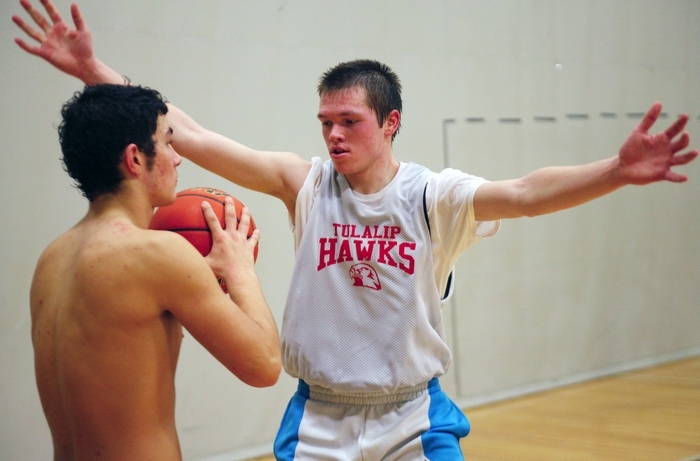
Keanu Hamilton (right) plays defense against teammate Ayrik Miranda during a recent Tulalip Heritage boys basketball practice.
By Aaron Lommers, The Herald
MARYSVILLE — The Tulalip Heritage boys basketball team has won three championships this season — a league championship, a district championship and a tri-district championship.
At the Spokane Arena on Thursday, the Hawks begin their quest for a fourth — and make no mistake, this is the one they really want.
A state championship is just three victories away for the Hawks, who face Neah Bay at 10:30 a.m. Thursday in the Class 1B state quarterfinals.
A big reason for the success Tulalip Heritage (26-1) has enjoyed this season has been the play of senior Keanu Hamilton, who recently was named the Northwest 1B League’s Most Valuable Player.
Not bad for a kid who hadn’t played organized basketball until his sophomore year of high school.
For a preview of the local schools involved in the 1A/2A and 1B/2B state tournaments, click here.
Hamilton, a 6-foot-1 guard/forward, was primarily a baseball player before he turned out for basketball nearly 2½ years ago. A natural athlete, Hamilton was fast and could jump, but the rest of his game needed a lot of work.
Asked if Hamilton came in with basic basketball skills, Tulalip Heritage head coach Marlin Fryberg replied, “Yeah … well … not really.”
Hamilton couldn’t make a layin, couldn’t dribble and couldn’t shoot. It was a rough start to his basketball career.
“Every time they threw the ball to me, I wouldn’t catch it,” Hamilton said. “I don’t know what (the problem) was, I just couldn’t catch the ball. I couldn’t even like walk and chew gum on the court. It was bad.”
Skills Hamilton’s teammates learned as children he was now trying to master as a teen-ager.
“People would stay stuff like, ‘You need to pivot. You learn that in kindergarten,'” Hamilton said. “I didn’t learn that in kindergarten. I learned that in my 10th-grade year.”
Hamilton was a project, but one Fryberg saw potential in from the beginning. Hamilton played on the junior varsity as a sophomore and began putting in the work that would land him on the varsity as a junior. Fryberg even started Hamilton a few times last season.
“That was the best feeling in the world, getting to start, because usually I just get cut from teams because I was really bad,” Hamilton said.
Hamilton doesn’t have to worry about getting cut anymore. His hard work has turned him into one of the most multi-dimensional 1B players in the state.
“Some kids don’t put in that work,” Fryberg said. “He’s definitely a different kid. To watch him over the past three years and see his progress is just phenomenal.”
The Hawks got off to a good start this season, but the first of their three victories over Lummi kicked the season into high gear. A double-digit win evened the regular-season series between the two teams and gave Tulalip Heritage a chance to capture the league title with a win over the Blackhawks in the third and final regular-season meeting — which they did.
In the district-title game, the Hawks defeated Lummi for a third consecutive time.
Riding high, Hamilton and the Hawks didn’t stop there.
In the tri-district championship game, Hamilton scored the game-winner in the final 10 seconds and the Hawks knocked off No. 1-ranked Neah Bay.
Tulalip Heritage senior point guard Bradley Fryberg, a senior transfer from O’Dea, beat his defender off the dribble and found Hamilton underneath the basket. With two defenders closing in, Hamilton put up the shot that gave his team a 68-66 win.
Fryberg-to-Hamilton is a one-two combination that has been working for much of the season.
“It’s gotten to that point to where it’s just instinct now,” Fryberg said of his connection with Hamilton. “You just know where he’s at.”
In just two years, Hamilton has gone from a player who could barely dribble to one of the most difficult players to defend at the 1B level, averaging about 18 points per game.
“He’s a coach’s nightmare,” Fryberg said. “If you try to guard this guy, you’ve got to put at least two guys on him because he just doesn’t quit.”
But for all Hamilton has accomplished, there is still one goal left on his list.
“I just want to win state,” he said.
After an 81-64 victory over Wilbur-Creston in Friday’s regional game, the Hawks are just three wins away.
It won’t be easy — three of the top five 1B teams in the state are in the top half of the bracket (No. 1 Neah Bay, No. 3 Tulalip Heritage and No. 4 Pomeroy).
“I told my boys, ‘What is a better way than to win it than by playing all the best teams in the state?'” Marlin Fryberg said.
While Neah Bay might have revenge on its mind stemming from the loss to Tulalip Heritage in the tri-district championship, the main focus for the Hawks is doing whatever it takes to get to the semifinals.
“It’s just a basketball game to us,” Marlin Fryberg said. “We’re going to go and put our work in and the best team is going to win — and I’m pretty confident it’s going to be us.”
President’s Indian Affairs Budget Request Promotes Strong Tribal Economies, Communities and Families
Press release, U.S. Department of the Interior
Exploring Culture: Tulalip Quil Ceda Elementary takes field trip to see Tulalip art
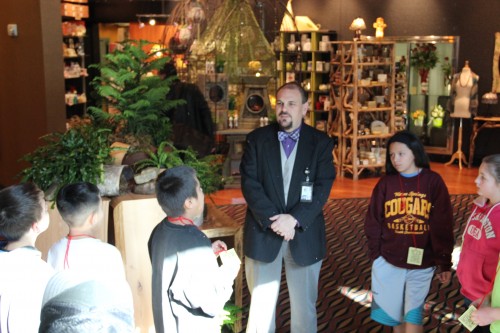
By Andrew Gobin, Tulalip News
The Tulalip Resort Casino adorned with traditional Coast Salish art provides an excellent place to learn about art outside of a class setting. Tulalip Quil Ceda Elementary 5th graders took field trips to the resort February 24th through the 28th to look at the artwork done by Tulalip artists. The students are currently learning about Coast Salish art styles, specifically styles of Puget Sound traditions.
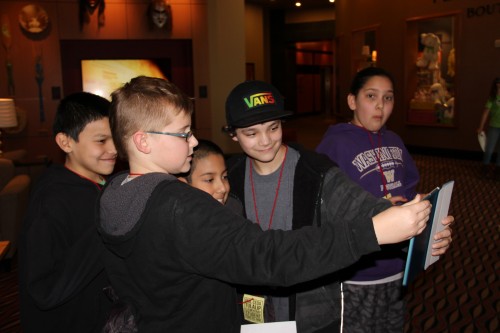
The kids struggled to keep from running, mesmerized by the art, losing themselves in the mystery and intrigue of coastal designs. The 5th grade students studied Coast Salish art before the excursion, learning the composition and design elements of the artwork. During their art period, Mr. Heimer took each class on different days throughout the week to see the art first hand. Groups of students conducted scavenger hunts looking for very specific designs with unique elements, making the students engage with the art, using classroom iPads to show what they thought was the correct design. For example, one item was a bear with a snout made from trigons and crescents. There are many bear designs throughout the resort, though each design is different. The student groups were all abuzz looking over their pictures, talking about the designs they had captured, going back to the designs to point out what they needed to photograph, demonstrating their intricate understanding of Coast Salish Traditional art.
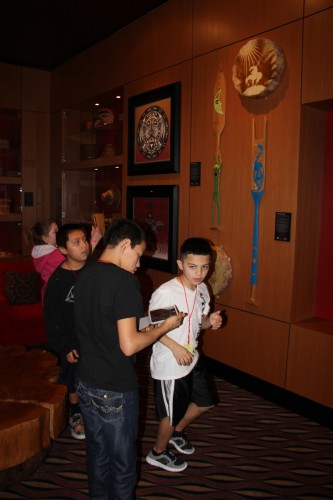
The trip, although short lasting only about 20 minutes, was important for the class. The students were excited to see the art, and even more excited to tell you about the art, explaining what different components were. They returned to class where their photos will be evaluated and graded. The school hopes to continue with similar activities, making their learning relatable on a local and human level.
Sidebar:
The classroom iPads at Tulalip Quil Ceda Elementary were purchased with National Education Association (NEA) School Improvement Grant (SIG) funding. You may recall the See-Yaht-Sub coverage of the NEA visit to the school, congratulating them for their excellent progress as one of the SIG schools, and wanted to know more about the role technology has played in making them a successful SIG school.
The technology levy for the Marysville School District, which recently was passed by voters, intends to incorporate other technology in every classroom in the district for similar uses. Progressive learning has arrived in the MSD.
Andrew Gobin is a reporter with the See-Yaht-Sub, a publication of the Tulalip Tribes Communications Department.
Email: agobin@tulaliptribes-nsn.gov
Phone: (360) 716.4188
Tulalip Heritage Hawks Regional Champions: Advance to State Championships in Spokane
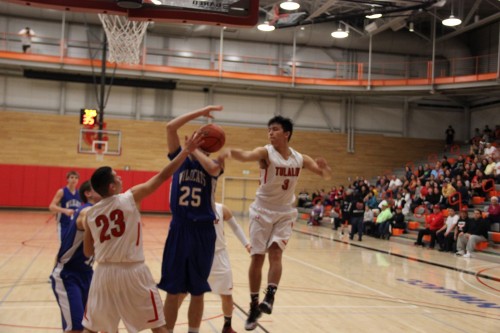
By Andrew Gobin, Tulalip News
The WIAA Regional Championship game held at Everett Community College February 28th was the final qualifying game for the State Championships in Spokane. The Tulalip Heritage Hawks took the Regional Championship Title over the Wilbur-Creston Wildcats, with a final score of 81-64 Tulalip. This loser-out game advances the Hawks to State, where they will play the Neah Bay Red Devils.
The Tulalip Heritage Hawks have said all year that this was their year to return to state, and bring home the championship title from Spokane. In recent years, they have come close, losing to their rivals, the Lummi Blackhawks, stopping their dreams of taking state just short of the championships. The Hawks have had an incredible season, currently ranked second in the state class, with an overall 26 wins and one loss to rival Lummi Blackhawks earlier in the season. Heritage defeated Lummi three more times since, including one game for the District Championship.

On Thursday, March 6th, Tulalip Heritage Hawks will face the Neah Bay Red Devils for the first game of the State Championships in Spokane. Tulalip defeated Neah Bay at the Tri-District Championship game 68-66, so this first game will be an intense rematch.

Andrew Gobin is a reporter with the See-Yaht-Sub, a publication of the Tulalip Tribes Communications Department.
Email: agobin@tulaliptribes-nsn.gov
Phone: (360) 716.4188
NCAI Encouraged By EPA Announcement Regarding Bristol Bay Salmon Fisheries
Press release, The National Congress of American Indians







